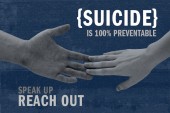Suicide and Your Child with Mental Illness
Sometimes you've just got to say the word: suicide.
Suicide is Preventable
Monday is World Suicide Prevention Day and if having the conversation saves even one life, it's worth breaking through the fear of "rocking the boat." Rock away.
Although dealing with my son Ben's schizophrenia has been no picnic, and at times I have feared for his life via accident or attack, we know we are lucky in that he has only spoken of suicide once, in the early onset phase of his illness 15 years ago. He tells me now that he was only trying to get my attention. Mission accomplished.
Yes, we are grateful. Last year, I trained a new class of NAMI Family-to-Family teachers in Connecticut. This training basically takes us through the educational and emotional journey of the 12-week course in one intense weekend - and sparks a lot of stories ranging from grief to relief.
[caption id="attachment_1097" align="alignleft" width="170" caption="Secret Plans Can be Worse"] [/caption]
[/caption]
We were "telling our stories" in one session, and though we all had tales of frustration, anger, hopelessness, and confusion, I will never forget the story of one participant who had lost her son to suicide years before (but still wanted to share her story to help others). She said, "I'd give anything to have the chance to fight with my son again."
Suicide robs us of hope. It robs our loved one of the future, of a second chance.
Can suicide be prevented? Many say yes - and that's what Suicide Prevention Day (and week) is all about.
Question. Persuade. Refer.
In NAMI Family-to-Family, we learn about QPR, a technique that can help. QPR stands for:
- Question
- Persuade
- Refer
A majority of those who attempt suicide give signals first. Prevention can begin with awareness (know the warning signs of suicide), and then the move to asking some hard questions, preferably in a private setting.
Prevention can begin with awareness (know the warning signs of suicide), and then the move to asking some hard questions, preferably in a private setting.
What are those questions? Here's a partial list:
- Have you been feeling unhappy?
- Do you ever feel hopeless? Like things can never get better?
- Do you have thoughts of death? DO you ever wish you could fall asleep and not ever wake up? (this could mean suicidal wishes, but not necessarily suicidal plans)
- Do you have any urge to kill yourself?
- Do you have actual plans to kill yourself? (ask for specifics, hard as it may be - danger is greatest if plan is clear and specific)
- When do you plan to kill yourself?
- Is there anything that would hold you back, like your family of religious beliefs? (a deterrant is a good sign, here)
- Have you ever made a suicide attempt in the past?
- Would you be willing to talk to someone or ask help if you feel desperate? Who? (if person is not willing to reach out for help, the situation is more dangerous)
Contrary to what you might think, asking the suicide question does not increase risk. It actually can be a relief, and puts it on the table for discussion. Listen to the answers first - don't refute right away. Hear them.
After the questions, try to persuade the individual to get help. Offer hope in any form, alternative solutions, better alternatives. And get the person to go for help - even offer to go with them.
Above all, don't ignore the signs. This will not go away if your head is in the sand. Prevention steps can work. Learn the steps now. You may need them later.
In life, there may be no guarantees. If you are reading this post, you probably know that all too well. But we can increase the odds with education, intervention, and support.
In the U.S., call 1-800-273-8255
National Suicide Prevention Lifeline
APA Reference
Kaye, R.
(2012, September 7). Suicide and Your Child with Mental Illness, HealthyPlace. Retrieved
on 2025, November 27 from https://www.healthyplace.com/blogs/mentalillnessinthefamily/2012/09/suicide-and-your-child-with-mental-illness